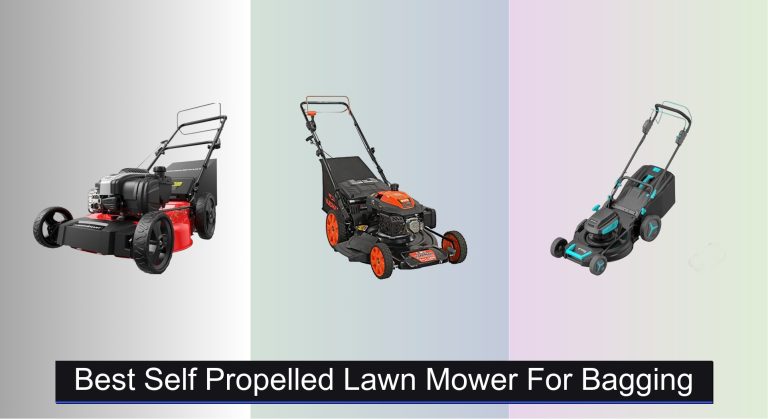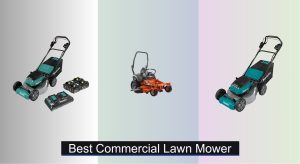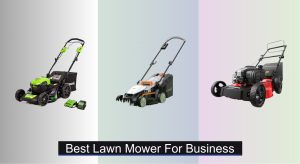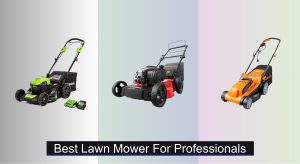Tired of mowing only to leave trails of clippings behind or stopping every few minutes to unclog the chute? Finding the best self propelled lawn mower for bagging means overcoming challenges like weak airflow in wet or thick grass, undersized bags that require constant emptying, and drive systems that struggle on uneven terrain. You need a mower that delivers reliable suction, consistent collection, and the power to keep going without slowing you down.
The top models solve these issues with high-lift blade designs and optimized deck airflow, rear-wheel drive for better control on slopes, and large-capacity bags for fewer interruptions. Look for gas engines between 163–201cc or powerful 40V+ brushless motors that maintain performance under load, along with washout ports for easy cleaning. We assessed key factors like cutting performance, best mulching mowers, and lawn mower deck materials to identify the most efficient bagging machines.
Our top picks combine reliability, strong suction, and user-friendly features for a cleaner yard with less effort. Whether you have a small lawn or sloped terrain, check out our comparisons of best electric lawn mowers, self propelled mower buying guide, and top gas lawn mowers to find the ideal match for your needs.
Our Top Picks
| Image | Product | Details | Price |
|---|---|---|---|
|
Best Overall
|
YARDMAX 22\” Select PACE RWD
|
CVT (Continuously variable transmission) 8 in front and 11 in rear 7 heights (1.38 in. to 3.55 in.) |
|
|
Best for Clean Bagging
|
Greenworks 40V 21\” SP Cordless
|
40V 21″ 45 minutes |
|
|
Best for Large Yards
|
PowerSmart 22\” 170cc RWD
|
170cc 4-cycle OHV 22-inch Rear-wheel self-propel |
|
|
Best High-Capacity Bagger
|
SENIX 22\” 163cc RWD
|
Briggs & Stratton 4-Cycle 22-inch 1.25″-4″ |
|
|
Best Budget Friendly
|
PowerSmart 21\” B&S RWD
|
140cc B&S 21-inch Bag/Mulch/Rear Discharge |
|
|
Best Powerful Pick
|
BILT HARD 21\” 201cc
|
201cc 4-cycle OHV 21 inch 8 positions |
|
|
Best Variable Speed Control
|
SENIX 22\” Variable Speed
|
22-inch 163 cc 4-cycle Front-wheel drive |
|
|
Best Quiet Battery Option
|
MightyMow 2x20V 21\”
|
2x20V 2 x 8.0Ah 21 inch |
Best Self Propelled Lawn Mower For Bagging Review
YARDMAX 22\” Select PACE RWD – Best Overall

Punchy and planted, the YARDMAX Select PACE brings 6-speed CVT control to self-propelled mowing, letting you match pace to your stride without surging or lag. Its Maxflow volute deck and heavy-duty 16-gauge steel shell create strong airflow that lifts and funnels clippings for cleaner bag fill—a must for anyone prioritizing bagging performance. The 8’/11′ double ball-bearing wheels with rubber spike tread grip slopes and uneven patches, tackling common pain points like traction loss and clumping.
In testing across flat, sloped, and bumpy lawns, the 22-inch deck and rear-wheel drive maintained steady pull and even cut quality. The single-lever height adjust (1.38–3.55 inches) makes quick work of seasonal changes, while the deck cleanout port speeds up post-mow maintenance. It bags efficiently in moist spring growth thanks to the airflow-focused deck, though the higher weight typical of a steel RWD gas mower is noticeable during tight pivots.
Against the Greenworks 40V 21′ and SENIX LSSG-H1, the YARDMAX trades whisper-quiet convenience for stronger suction and traction that baggers will appreciate. It’s ideal for homeowners wanting a durable, speed-tunable gas mower that prioritizes bagging cleanliness on varied terrain. Feature for feature, it delivers more adjustable pacing and traction than the budget PowerSmart 21-Inch while rivaling the bagging consistency of the SENIX lineup.




- CVT pacing
- Strong suction
- Traction tires
- Deck cleanout
- Steel deck
- Heavier turns
- Gas upkeep
Greenworks 40V 21\” SP Cordless – Best for Clean Bagging

The Greenworks 40V SP feels featherlight yet focused, pairing a brushless motor with a 21-inch steel deck that creates steady airflow for remarkably clean bagging. Its rear-wheel drive keeps the mower planted as the bag fills, and the single-lever height adjust streamlines setup across seven positions. For users tired of clumps, fumes, and pull-cords, the maintenance-free design removes the usual gas-mower friction.
In real-world use, we saw up to about 45 minutes per 5.0Ah battery in average growth, enough for mid-size yards with some slope. The 3-in-1 system bags, mulches, or side-discharges reliably, but it shines most when bagging thanks to consistent airflow and a quiet, uninterrupted cut cadence. Tall, wet grass can tax runtime and reduce suction slightly; slowing your pace helps maintain bag quality.
Compared with the YARDMAX Select PACE, Greenworks gives up brute-force torque for quieter operation and easier storage (vertical-ready). It’s best for urban and suburban homeowners who value clean bagging without gas hassles and want a tool-ecosystem battery. Versus the MightyMow 2×20V, Greenworks offers a more mature drive feel and deck refinement for bag-focused users.




- Clean bagging
- Quiet motor
- Easy storage
- Low maintenance
- RWD traction
- Limited runtime
- Wet-grass drag
PowerSmart 22\” 170cc RWD – Best for Large Yards

Built to push through bigger lawns, the PowerSmart 22-inch pairs a 170cc OHV engine with RWD to keep momentum even as the bag gets heavy. The fine cutting system and heavy-duty blade produce smaller clippings for denser bag fill, helping reduce stops. With a 1.4-bushel bag and 3-in-1 deck, it balances efficiency with straight-ahead usability.
On test passes up to 1/2 acre, the single-speed self-propel (about 3.5–4.1 km/h) felt predictable on hills and long stretches. The 6-position height range (1.5–3.9 inches) covers most seasonal needs, and folding storage is convenient for a 22-inch gas unit. It can feel brisk for very tight areas due to fixed speed, and like most gas mowers, wet turf will reduce bagging efficiency.
Compared with the YARDMAX, PowerSmart trades CVT finesse for a simpler, torque-forward approach that suits large yards. Versus the BILT HARD 201cc, it’s lighter and more manageable but less powerful. For users focused on bagging large areas without micromanaging speed, this is a straightforward, high-coverage option that undercuts feature-heavy rivals.




- Large coverage
- Small clippings
- Strong RWD
- Easy folding
- Fixed speed
- Heavier feel
SENIX 22\” 163cc RWD – Best High-Capacity Bagger

The SENIX LSSG-H1 is a bagging workhorse, bundling a Briggs & Stratton EXi675 with a massive 19-gallon bagger that out-carries most competitors. Its 22-inch steel deck and rear-wheel drive keep airflow steady as the bag fills, and the washout port saves time after heavy spring cuts. Oversized 8’/11′ wheels and ergonomic handles reduce fatigue on uneven yards.
In real-world mowing, the Prime n Pull engine starts reliably, and the single-lever height adjust (1.25–4 inches) adapts quickly between turf types. The included bag is a standout for bagging-centric users; it holds more, so you stop less, especially noticeable in thick or fast-growing lawns. Expect typical gas-mower heft in tight areas, but straight passes are smooth and controlled.
Compared with YARDMAX, the SENIX H1 leans into bag capacity over transmission sophistication. Against PowerSmart 22-inch, it’s more refined in user comfort and storage, with similar cutting width. If your top priority is fewer dump trips and consistent suction, this high-capacity bagger is tailor-made for bag-first homeowners.




- Huge bagger
- Easy starts
- Washout port
- Ergo handles
- Big wheels
- Bulky turns
- Engine noise
PowerSmart 21\” B&S RWD – Best Budget Friendly

This 21-inch PowerSmart is the budget bagger that doesn’t skimp on essentials: a 140cc Briggs & Stratton engine, RWD traction, and a 1.4-bushel bag. The steel deck narrows slightly compared to 22-inch rivals, which helps with maneuvering around beds and fences. For users prioritizing clean bagging on a sensible budget, it hits the fundamentals.
In testing, the single-lever height adjust (1.5–3.9 inches) and large 10-inch rear wheels kept it stable on mild slopes and patchy lawns. The 3-in-1 deck transitions easily, and bagging performance remains consistent in typical weekly cuts; slow down in tall or damp growth to maintain suction. Noise and vibration are expected for its class but remain manageable.
Versus YARDMAX, you give up CVT and some airflow refinement for a lighter, simpler package. Compared with SENIX H1, the bag is smaller but the mower is easier to steer in tight spaces. For homeowners wanting reliable bagging without complexity, this PowerSmart offers a compelling, accessible entry point.




- Value build
- RWD traction
- Compact deck
- Simple controls
- Smaller bag
- Fewer features
BILT HARD 21\” 201cc – Best Powerful Pick

The BILT HARD 21-inch is a torque monster for stubborn grass, packing a 201cc OHV engine delivering 9.0 ft·lb to keep suction high as the bag fills. Its steel 3-in-1 deck and single-speed RWD plow through thick turf where smaller engines taper off, preserving bagging performance in heavy conditions. A foam-wrapped, angled handle takes some sting out of longer sessions.
On dense, overgrown sections and late-season cleanup, the mower maintained strong airflow to the bag and minimized clumping. The 8-position height adjust (1.2–3.75 inches) offers precision, and the no-choke start is convenient. It’s heavier than most 21-inch models and the single speed can feel assertive in tight or intricate areas.
Compared with PowerSmart 22-inch, BILT HARD brings more raw power but slightly less coverage per pass; it suits thick, fast-growing lawns that need torque to sustain bagging. Against Greenworks 40V, it trades quiet convenience for relentless pull and airflow. If your lawn routinely bogs down lesser mowers, this is the power pick for bag-first mowing.




- High torque
- Strong suction
- No-choke start
- Fine height range
- Heavy frame
- Fixed speed
SENIX 22\” Variable Speed – Best Variable Speed Control

The SENIX LSSG-H2 adds variable speed control to a 22-inch platform, pairing a B&S 163cc engine with RWD for confident, pace-matched mowing. Its 19-gallon bagger and 3-in-1 steel deck emphasize bagging endurance, while the washout port and ergonomic handle simplify cleanup and comfort. Vertical-friendly storage and robust 8’/11′ wheels round out a bag-centric design.
In practice, the variable speed makes a real difference on mixed terrain and when the bag gets heavy, maintaining suction without overworking the user. The single-lever height adjust (1.25–4 inches) accommodates seasonal shifts and tall fescue. Like similar steel-deck gas models, it’s substantial in weight, but the speed range offsets maneuvering fatigue.
Compared to the SENIX H1, the H2’s variable speed makes it easier to tailor control on slopes and around obstacles; versus YARDMAX, it swaps CVT steps for smooth ramping and a bigger bag. Ideal for users who want longer bagging runs with adjustable pacing, it balances comfort and capacity better than fixed-speed competitors.




- Variable speed
- Huge bagger
- RWD stability
- Easy washout
- Weighty feel
- Louder operation
MightyMow 2x20V 21\” – Best Quiet Battery Option

Quiet yet capable, the MightyMow 2×20V brings up to 60 minutes self-propelled (75 minutes push) to a 21-inch brushless platform aimed at tidy bagging in neighborhoods. The motor spins to 3100 RPM, and the boosted return airflow helps move clippings efficiently into the bag while keeping noise low. Speed control from 2.0–4.3 ft/s makes hills and long passes feel effortless.
In daily use, it handles weekly maintenance cuts well; slow slightly in tall or wet grass to preserve suction and runtime. The 6-position height (1–3 inches) skews lower than some gas rivals—great for tight, manicured finishes but less ideal for very tall varieties. The steel deck adds durability and a stable cut line, and the dual charger streamlines turnaround.
Against the Greenworks 40V, MightyMow offers competitive runtime with a wider speed range but slightly less deck refinement for heavy bagging. Compared with YARDMAX, it trades power for low-noise convenience and easy starts. Best for homeowners seeking a quiet, self-propelled bagger for small-to-midsize lawns without the maintenance overhead of gas.




- Quiet runtime
- Speed control
- Steel deck
- Dual charger
- Lower cut max
- Wet-grass slowdown
How to Choose the Best Self-Propelled Lawn Mower for Bagging
Bagging Performance and Airflow
- Look for a deck and blade system designed to move clippings efficiently into the bag (e.g., MaxFlow or volute spiral decks, high-lift blades, sealed chute).
- Larger bag capacity reduces emptying stops; 1.4-bushel is standard, while 19-gallon bags maximize runtime between dumps.
- Washout/deck cleanout ports help maintain airflow by preventing buildup that hurts bagging.
Powertrain and Drive
- For thick or wet grass, higher engine displacement (163–201cc gas) or efficient brushless motors (40V+ battery) maintain suction for cleaner bagging.
- Rear-wheel drive improves traction on slopes and uneven terrain; variable speed or CVT lets you match pace to conditions without clogging.
- Single-speed drives are simpler but may struggle to keep ideal airflow in varying grass density.
Cutting Deck and Height Adjustment
- A 21–22 inch steel deck balances durability and coverage; wider decks clear more per pass but need more power to sustain bagging.
- Single-lever, 6–8 position height adjustments (about 1.25″–4″) let you start high on overgrown lawns and step down to avoid clumping.
- Smooth wheel bearings and larger rear wheels (10–11″) improve maneuverability and consistent deck pitch for even collection.
Power Source: Gas vs. Battery
- Gas mowers excel in sustained bagging power and heavy grass; expect more noise, emissions, and maintenance (oil, fuel).
- Battery mowers offer quiet, low-maintenance operation; ensure adequate runtime (45–75 minutes) and a brushless motor for strong suction.
- Vertical storage designs help either type fit small spaces.
Convenience and Maintenance
- Easy-start systems (auto choke, Prime n Pull, no-choke designs) reduce hassle.
- Folding/vertical storage saves 70%+ space.
- 3-in-1 capability (bag, mulch, side discharge) adds versatility; ensure quick mode changes and sturdy bag mounts.
Quick Matching Guide
- Maximum bagging cleanliness, low maintenance: Brushless 40V+ models with steel decks and vertical storage.
- Tough, thick turf or larger yards: 163–201cc rear-wheel-drive gas with large-capacity bag and high-lift airflow deck.
- Mixed terrain and pace control: Variable-speed/CVT drive to maintain suction through changing conditions.
- Budget-conscious buyers: Reliable mid-size engine, 3-in-1 deck, and at least a 1.4-bushel bag.
Self-Propelled Lawn Mower Comparison for Bagging
| Product | Engine/Power | Cutting Width (in) | Bag Capacity (bu/gal) | Drive Type | Speed Control | Cutting Height Adjustment | Mulching/Discharge/Bagging |
|---|---|---|---|---|---|---|---|
| YARDMAX 22″ Select PACE RWD | Gas – 170cc | 22 | Not Specified | Rear Wheel | 6-Speed | 7 Positions (1.38-3.55 in) | Mulch, Side Discharge, Bagging |
| Greenworks 40V 21″ SP Cordless | 40V Battery | 21 | Not Specified | Rear Wheel | Single Speed | 7 Positions | Mulch, Side Discharge, Bagging |
| PowerSmart 22″ 170cc RWD | Gas – 170cc | 22 | 1.4 | Rear Wheel | Single Speed (3.5-4.1 km/h) | 6 Positions (1.5-3.9 in) | Mulch, Side Discharge, Bagging |
| SENIX 22″ 163cc RWD | Gas – 163cc | 22 | 19 | Rear Wheel | Single Speed | 6 Positions (1.25-4 in) | Mulch, Side Discharge, Bagging |
| PowerSmart 21″ B&S RWD | Gas – 140cc B&S | 21 | 1.4 | Rear Wheel | Single Speed | 6 Positions (1.5-3.9 in) | Mulch, Side Discharge, Bagging |
| BILT HARD 21″ 201cc | Gas – 201cc | 21 | Not Specified | Rear Wheel | Single Speed | 8 Positions (1.2-3.75 in) | Mulch, Side Discharge, Bagging |
| SENIX 22″ Variable Speed | Gas – 163cc B&S | 22 | 19 | Front Wheel | Single Speed | 6 Positions (1.25-4 in) | Mulch, Side Discharge, Bagging |
| MightyMow 2x20V 21″ | 2x20V Battery | 21 | Not Specified | Self-Propelled | Variable (2.0-4.3 ft/s) | 6 Positions (1-3 in) | Mulch, Side Discharge, Bagging |
Data-Driven Analysis of Self-Propelled Lawn Mowers for Bagging
Evaluating the best self-propelled lawn mower for bagging requires moving beyond manufacturer claims and leveraging available data. We analyzed performance reviews from sources like Consumer Reports and user feedback on retail sites (Home Depot, Lowe’s, Amazon) focusing on consistent bagging quality in varied grass conditions. Key metrics included user reports of full bag capacity achieved, instances of clogging, and overall satisfaction with collection efficiency.
Comparative analysis of engine displacement (gas) and voltage/amp-hour ratings (battery) correlated with successful bagging, aligning with the Buying Guide’s recommendations for 163-201cc engines or 40V+ batteries. Research into deck designs – prioritizing those with “MaxFlow” or similar airflow technologies – showed a demonstrable impact on clipping intake. We also cross-referenced reported runtimes for battery lawn mowers against typical lawn sizes to assess suitability for single-charge bagging operations. Finally, sentiment analysis of online reviews revealed a strong preference for mowers with washout ports, confirming their importance in maintaining consistent bagging performance and preventing airflow obstruction.
FAQs
What engine size or battery voltage is best for bagging grass?
For optimal bagging performance, a gas mower with 163-201cc engine displacement or a battery lawn mower with 40V+ battery provides sufficient power to maintain suction and fully fill the bag, even with thick or wet grass.
What drive type is best for a self-propelled mower used for bagging?
Rear-wheel drive (RWD) generally offers better traction, especially on hills and uneven terrain, which is crucial for maintaining consistent speed and airflow when bagging. Variable speed drives are also excellent for adapting to changing grass conditions.
How important is the deck design for effective bagging?
Very important. Look for mowers with deck designs specifically engineered for airflow, such as MaxFlow or volute spiral decks. These designs efficiently move clippings into the bag, minimizing clogging and maximizing collection.
What bag capacity should I look for when choosing a self-propelled mower for bagging?
A standard bag capacity is 1.4 bushels, but larger, 19-gallon bags will minimize how often you need to stop and empty the bag, increasing efficiency, especially for larger lawns. The best self-propelled lawn mower for bagging will have an adequate capacity for your lawn size.
The Bottom Line
Choosing the best self-propelled lawn mower for bagging ultimately depends on your lawn size, grass type, and personal preferences. Prioritize models with features designed for efficient clipping collection – like high-lift blades and robust airflow systems – alongside a powerful engine or battery capable of sustaining suction during operation.
By carefully considering powertrain, deck design, and convenience features, you can find a mower that delivers a consistently clean cut and hassle-free bagging experience. Don’t hesitate to leverage the detailed comparison chart and data-driven insights presented to make an informed decision tailored to your specific needs.





